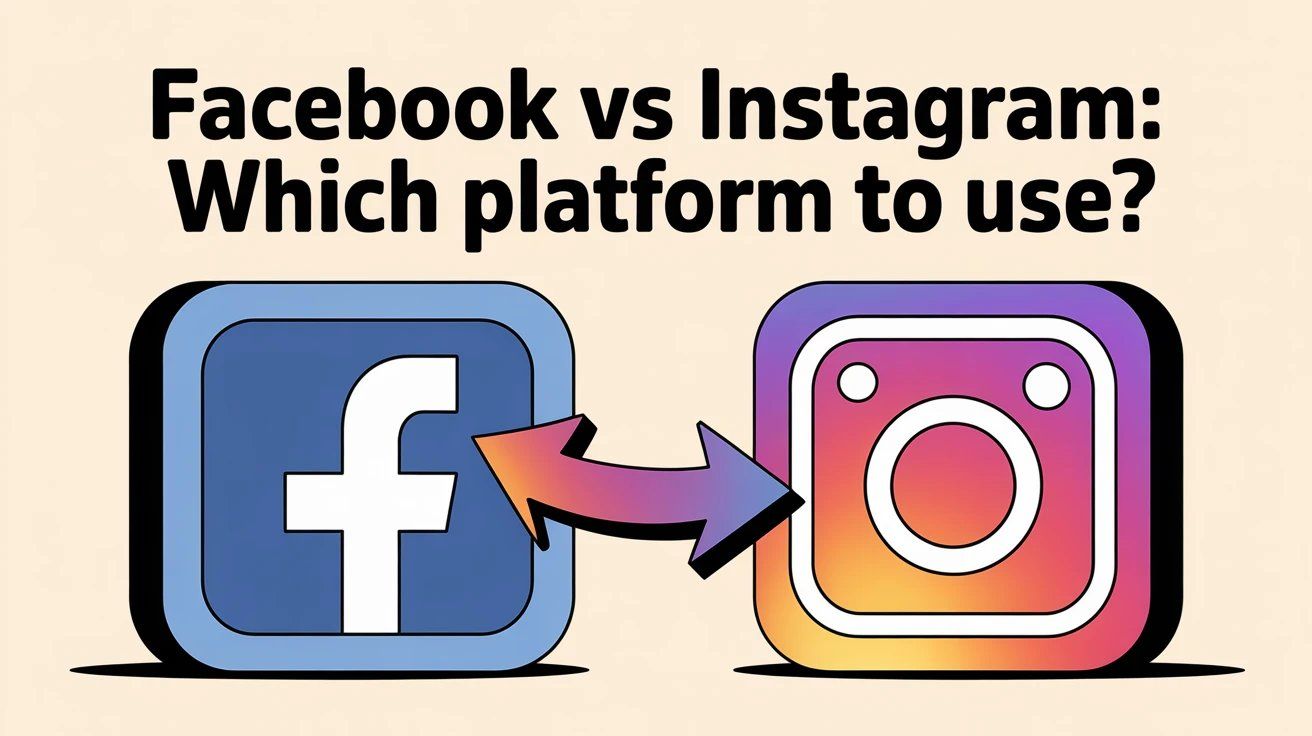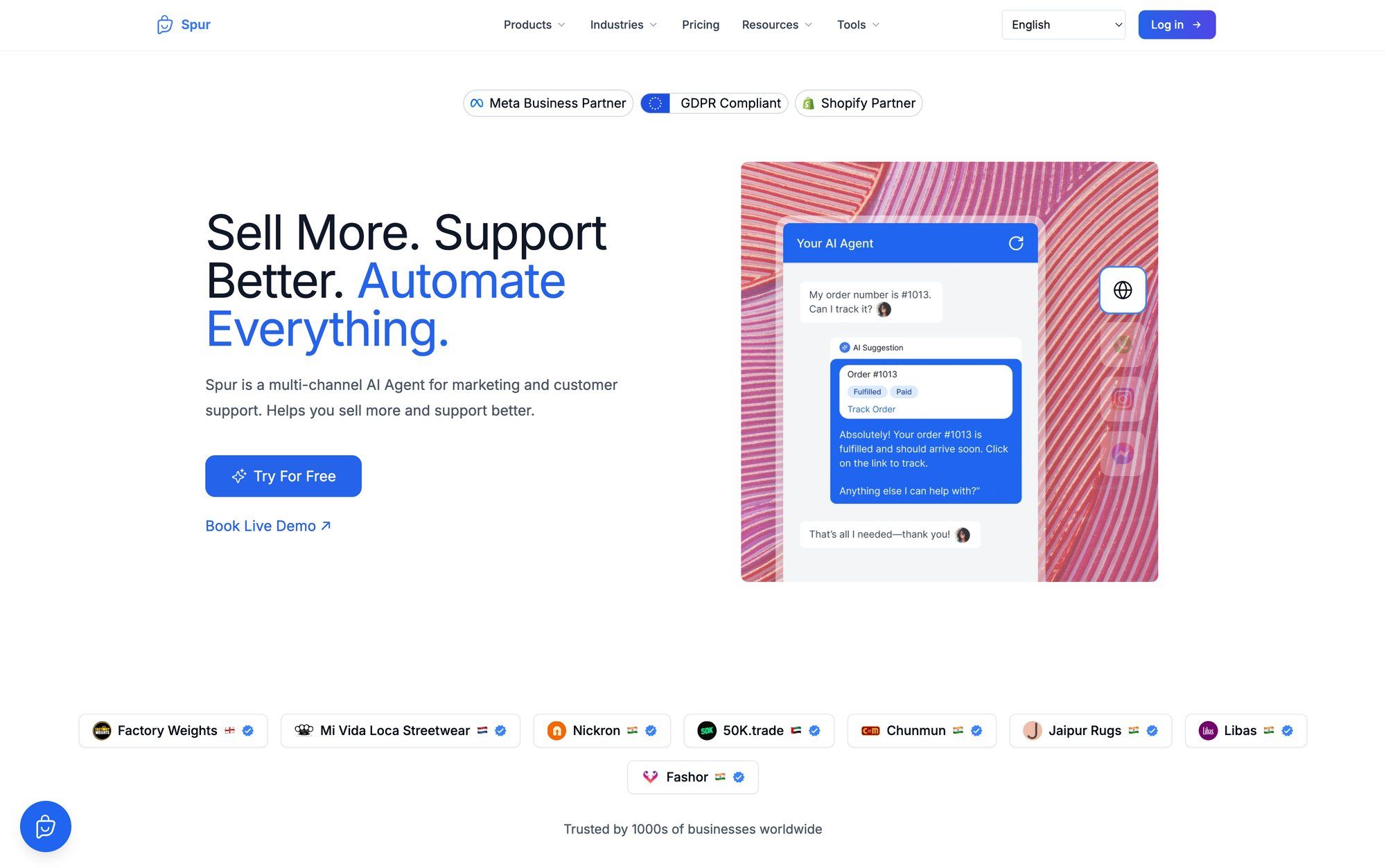
Facebook vs Instagram: Which Platform To Use in 2025?
Discuss with AI
Get instant insights and ask questions about this topic with AI assistants.
💡 Pro tip: All options include context about this blog post. Feel free to modify the prompt to ask more specific questions!
TL;DR: Facebook reaches broader demographics (especially adults 25+) and excels at community building and link sharing, while Instagram dominates with visual content and Gen Z engagement. Use Facebook for detailed posts and diverse age targeting. Use Instagram for product showcases and younger audiences. Smart businesses use both platforms strategically with Spur to automate customer engagement across channels.

Both Facebook and Instagram live under Meta's umbrella, but choosing between them isn't straightforward. Your business might thrive on one and struggle on the other (or need both). The platforms attract different audiences, favor different content formats, and serve distinct purposes in your marketing mix.
Before we get into differences, let's acknowledge the similarities. Both platforms are social networks owned by Meta. They integrate with Meta's advertising ecosystem, support visual content through photos and videos, and feature Stories and Reels for short-form video.
Users on both can follow accounts, tag friends, send direct messages, and shop through integrated e-commerce features. Each platform boasts billions of monthly users globally, making them among the largest social networks on Earth.
But here's where similarities end.

Facebook started as a text-friendly network. You can post status updates, share links, and create posts without images. The platform was built for sharing thoughts, articles, and having discussions.
Instagram, by contrast, requires an image or video for every post. It's a visual-first platform built around photos and short videos. Captions exist but play a supporting role.
The fundamental difference: Facebook allows text without images. Instagram requires visuals for every post. This shapes everything about how the platforms work.

| Feature Type | ||
|---|---|---|
| Text-Only Posts | ✓ Full support | ✗ Not possible |
| Photo Albums | ✓ Full album feature | Limited (carousels only) |
| Link Sharing | ✓ Clickable with previews | Bio and Stories only |
| Long-Form Content | ✓ Articles and detailed posts | Short captions preferred |
| Video Format | Short and long-form | Reels and Stories (short-form) |
Facebook supports a wide range of content:
• Text-only posts (status updates without media)
• Photo albums (perfect for events, behind-the-scenes content)
• Long-form text and article sharing
• Clickable links with automatic previews
Links work differently on Facebook. When you share a URL, it generates a preview card, and users can click through to your website. This makes Facebook powerful for driving traffic to blog posts, product pages, or landing pages.
Instagram offers:
• Single images or videos (with up to 10 in a carousel)
• Stories (disappearing 24-hour content)
• Reels (short-form video)
• No clickable links in captions or comments
That last point matters. On Instagram, you can't add clickable links to posts. The only places live links work are your bio and Story link stickers. If you reference a URL in a post, you have to tell followers "link in bio."
Instagram doesn't have photo albums like Facebook does. You can create multi-image carousels or save Stories as Highlights, but there's no album feature for organizing batches of photos on your profile.

Facebook works seamlessly on desktop and mobile. You can create posts, manage Pages, respond to messages, and run ads from your computer or phone. The web interface is robust and fully functional.
Instagram is designed for mobile. You can browse on desktop, but the experience is limited. Posting Stories, Reels, and using most features requires the mobile app. Instagram assumes you're on your phone, scrolling while commuting, waiting in line, or relaxing.
This affects how people consume content. Facebook users might read long articles or participate in group discussions on their laptop. Instagram users are scrolling through visual feeds on their phones, looking for quick hits of inspiration or entertainment.
Facebook goes beyond social sharing with features like:
→ Groups
Private or public communities where members discuss shared interests. Perfect for building engaged audiences around topics, hobbies, or your brand.
→ Events
Organize virtual or in-person events with RSVPs, updates, and reminders. Great for product launches, webinars, or local meetups.
→ Marketplace
A Craigslist-style section for buying and selling items locally.
→ Games and Apps
Third-party integrations that run on the platform (remember FarmVille?).
Instagram has none of these. Interaction on Instagram happens through posts, Stories, and DMs. There are no groups, no event pages, no marketplace. Facebook is an all-in-one social hub. Instagram sticks to visual content sharing and discovery.
A Facebook Page can be detailed, with sections for business hours, contact information, reviews, services, and more. It's almost like a mini-website.
An Instagram profile is minimalist: a 150-character bio, one link, a category label, and contact buttons. That's it.
| Demographics | ||
|---|---|---|
| Total Users | ~3 billion monthly | ~2 billion monthly |
| Largest Age Group | 25-34 years (18-31%) | 18-24 years (Gen Z) |
| Ages 50-64 | 70% usage (U.S.) | Low penetration |
| Ages 65+ | 58% usage (U.S.) | ~15% usage (U.S.) |
| Gender Split | 56% male globally | ~50/50 split |
| Core Strength | Broad age appeal | Youth-focused |
Facebook has around 3 billion monthly users, making it the largest social network globally. Its audience spans all age groups, but it's particularly strong with adults.
The biggest segment globally is people 25-34 years old (about 18-31% of users). But Facebook also dominates with older demographics:
• 70% of U.S. adults aged 50-64 use Facebook
• 58% of seniors 65+ are on the platform
Facebook caters to older demographics far more effectively than any other major social network. If your target market includes Gen X or Baby Boomers, Facebook is non-negotiable.
Instagram has over 2 billion monthly users, and its core audience skews young:
• Largest age group: 18-24 (Gen Z)
• Second largest: 25-34 (younger Millennials)
Only about 15% of adults 65+ use Instagram in the U.S. The platform's vibe and content reflect this youth-oriented demographic: trending audio, aesthetic photos, influencer culture, and fast-scrolling short videos.
The age demographics vary sharply. If you sell to teens and twentysomethings, Instagram is where you need to be. If your customers are 45+, Facebook will outperform.

Facebook's global user base is about 56% male, though U.S. demographics tilt more female. Instagram's gender split is roughly 50/50. Both platforms have broad appeal across genders, but these nuances matter when refining targeting.
| Engagement Type | ||
|---|---|---|
| Median Rate | ~1% | ~5% |
| Interaction Style | Detailed comments, shares | Quick likes, double-taps |
| Content Sharing | Easy external sharing | On-platform only |
| Discussion Depth | Deep conversations | Quick reactions |
| Community Building | Groups and threads | Visual inspiration |
Instagram's design encourages rapid scrolling and quick interactions. Users double-tap to like dozens of posts in minutes. The result? Instagram's median engagement rate is around 5%, far higher than Facebook's ~1%.
Visual content (beautiful product photos, trending Reels) gets instant likes and comments, especially from younger users. The platform keeps engagement on-platform because you can't easily share links out.
Facebook engagement looks different. Users might not like every post, but they'll:
• Write detailed comments
• Share posts with personal commentary
• Participate in group discussions
• Send links to friends via Messenger
A brand's Facebook post might average only 30 interactions versus 300 on Instagram, but those Facebook interactions could include meaningful conversations, shares into niche groups, or detailed questions. Instagram wins for fast, high-volume engagement, while Facebook shines for deeper discussions and community-driven interaction.
Critical insight: Instagram delivers high-volume, quick engagement. Facebook creates space for deeper conversations and community building. Both matter, but they serve different marketing goals.
| User Intent | ||
|---|---|---|
| Primary Use | Connection and information | Discovery and aspiration |
| Content Consumption | Articles, discussions, events | Visual inspiration, trends |
| Business Focus | Customer service, community | Brand aesthetics, products |
| Link Behavior | Click through to websites | Stay on-platform |
| Discovery Method | Groups, friends, pages | Hashtags, Explore, influencers |
Users go to Facebook to:
• Catch up with friends and family
• Read news articles and blog posts
• Participate in interest groups
• Find local events and services
• Get customer support from businesses
Facebook is about connection and information. Businesses use Facebook for customer service (via Pages and Messenger automation), sharing detailed updates, organizing events, and running targeted ad campaigns to diverse demographics.
Users open Instagram to:
• Discover inspiring visual content
• Watch entertaining short videos
• Follow influencers and brands
• Shop for products they see in posts
• Share moments through Stories
Instagram is about discovery and aspiration. Businesses focus on brand aesthetics, product showcases, influencer partnerships, and hashtags to reach new audiences.

Both platforms use Meta's advertising system, so you can run campaigns on either (or both) from one interface.
Facebook's ad platform is legendary for granular targeting. You can target by demographics, interests, behaviors, and life events with incredible precision. The platform works well for:
• Article/blog traffic
• Reaching older buyers
• Detailed product launches
Instagram ads use the same targeting data but emphasize visual formats: image ads, video ads, Story ads, and shoppable posts. Instagram excels at:
• Brand awareness among young consumers
• Product showcase for fashion, beauty, lifestyle
• Influencer-style sponsored content
Both platforms support social commerce through Facebook Shops and Instagram Shop. Businesses can create product catalogs that appear in-app.
Instagram's shopping experience is more seamless for D2C brands. Users see a product tag on a photo, tap it, and view details without leaving the app. Facebook can list products too, but users typically click out to your website rather than buying in-platform.

Both Facebook and Instagram support message automation through official APIs. This is where tools like Spur become valuable.
With Spur, businesses can:
• Automate Instagram comment replies (perfect for "Comment 'INFO' for details" campaigns)
• Handle Facebook Messenger inquiries with AI agents
• Unify both channels in one shared inbox
• Train AI on your knowledge base to answer customer questions accurately
The automation types differ slightly. On Facebook, you might auto-respond to Page messages or comment triggers. On Instagram, automation commonly handles comment-to-DM flows and new message greetings.
Being an official Meta partner, Spur lets you capture leads from Instagram comments or Facebook post messages in one place, with AI agents that can actually take action (track orders, book appointments) rather than just answering FAQs.

There's no universal answer. The right choice depends on your audience, content, and goals.
Your audience is under 35 and your content is highly visual.
Instagram is ideal for brands in fashion, beauty, food, travel, or any sector where visuals tell the story. It offers high engagement on photos and short videos, and it's perfect for working with influencers to reach new audiences.
If you want to showcase products through lifestyle images and gain followers through engaging visuals, Instagram is your platform. (A restaurant might post drool-worthy dish photos and behind-the-scenes Reels.)
You need to reach broader and older demographics, or you focus on community and information-sharing.
Facebook is unmatched for targeting diverse age groups including Gen X and Boomers. It's the better platform for sharing blog posts, articles, detailed updates, and driving traffic to external websites (thanks to clickable links).
Facebook excels at local marketing, events, groups, and customer support. If your business benefits from discussion (a tech company with a user forum, or a fitness brand with a community group), Facebook facilitates that community-building.
Facebook's mature ad platform and retargeting tools often deliver strong direct response results, especially for lead generation campaigns targeting specific ages and locations.
In most cases, the optimal strategy is using both platforms differently.
① Distribute Content Thoughtfully
Share longer, informative posts on Facebook. Keep your Instagram feed focused on polished visuals and quick updates.
② Play to Each Platform's Strengths
Use LinkedIn for thought leadership, Instagram for product showcases, and Facebook for targeted ad campaigns.
③ Maintain Consistent Brand Voice
Each platform plays a role. The key is playing to each platform's strengths while maintaining a consistent brand voice.
Your customers don't care which platform they message you on. They expect fast, helpful responses whether they DM on Instagram, message on Facebook, or chat on your website.
Managing conversations across multiple channels manually isn't scalable. You need a unified system.
Spur solves this with:
All Instagram DMs, Facebook messages, WhatsApp chats, and website live chat conversations in one place. Your team doesn't need to toggle between apps.
→ AI Agents Trained on Your Data
Unlike basic chatbots, Spur's AI agents learn from your knowledge base and can take actions like tracking orders or booking appointments. (This is a key advantage over tools like Manychat, which can't train AI on your own data.)
Run abandoned cart campaigns on WhatsApp, automate Instagram comment responses, and send targeted broadcasts across channels.
→ User-Friendly Setup
Spur is designed for businesses, not just technical teams. You can set up automation flows without writing code (unlike more complex tools like Botpress).
When you're managing customer conversations across Facebook, Instagram, and other channels, having one tool that handles them all (with smart automation) is a competitive advantage.

| Aspect | ||
|---|---|---|
| Core Focus | Text, links, and community | Visual content and discovery |
| Primary Audience | Broad (all ages, strong with 25-65+) | Young (18-34 dominant) |
| Content Types | Text posts, links, albums, video | Photos, videos, Reels, Stories |
| Link Sharing | Full support with previews | Bio and Stories only |
| Engagement Style | Deeper discussions, shares | Quick likes, high volume |
| Best For | Community building, traffic generation | Brand aesthetics, product showcase |
| Ideal Industries | B2B, local businesses, news, events | Fashion, beauty, food, lifestyle, travel |
| Platform Experience | Desktop and mobile | Mobile-first |
| Additional Features | Groups, Events, Marketplace | None (focused on core experience) |
Both Facebook and Instagram evolve constantly. Meta regularly adds features (Instagram's Reels updates, Facebook's emphasis on Groups) and user behavior shifts over time.
In 2025, Facebook remains the world's largest social network with 3 billion users, and Instagram is a close powerhouse at 2 billion. A smart brand stays aware of where their audience spends time and adjusts content strategy accordingly.
The key is understanding each platform's strengths and creating content that thrives in each environment while maintaining a consistent brand voice.
Facebook and Instagram serve different purposes in your marketing mix. Facebook offers scale, community features, powerful link sharing, and reach across all age groups. Instagram delivers visual impact, high engagement rates, and dominance with younger consumers.
Understanding these differences helps you create content that works on each platform. Better yet, integrate both to cover all bases.
No matter which platform you focus on, meeting your audience where they prefer to engage (and delivering value in the format they love) is the recipe for social media success. And when you're managing conversations across multiple channels, tools like Spur ensure you never miss a message or opportunity.
Can I post the same content on both Facebook and Instagram?
You can, but you shouldn't without adapting it. Instagram requires an image or video for every post, while Facebook supports text-only updates. Instagram captions work best when short and punchy. Facebook allows longer text. Optimize each post for the platform you're using for best results.
Which platform is better for e-commerce businesses?
It depends on your product and audience. Instagram excels for visually appealing products (fashion, beauty, home decor) targeting younger buyers. Facebook works well for diverse products, especially when targeting older demographics or driving traffic to your website. Many successful e-commerce brands use both strategically.
Do I need different advertising strategies for Facebook vs Instagram?
Yes. Facebook ads often focus on detailed targeting and driving website traffic or lead generation. Instagram ads emphasize visual appeal and brand awareness. Both use Meta's ad platform, so you can run campaigns on either, but creative and objectives should match the platform's strengths.
How important is video content on each platform?
Very important on both, but differently. Instagram prioritizes short-form video (Reels, Stories) that's casual and trend-driven. Facebook supports both short and long-form video, including live streaming and detailed product demos. Video performs well on both platforms but with different styles.
Can I automate customer messages on both platforms?
Yes. Both Facebook and Instagram support message automation through Meta's official APIs. Tools like Spur let you automate responses to Instagram comments and DMs, Facebook Messenger chats, and manage everything from a unified inbox with AI agents that can actually help customers (not just answer FAQs).
Which platform has better organic reach?
Both platforms have limited organic reach compared to their early days, prioritizing paid advertising. Instagram tends to offer better organic engagement rates on individual posts (around 5% vs Facebook's 1%), but Facebook's Groups feature can provide strong organic reach within communities. Don't rely solely on organic reach on either platform.
How do Instagram and Facebook differ for local businesses?
Facebook is generally better for local businesses due to its Events feature, Marketplace, detailed location targeting, and higher usage among local community members across age groups. Instagram can work for local businesses with strong visual appeal (restaurants, salons), but Facebook's community features give it an edge for local marketing.
Is one platform easier to manage than the other?
Facebook offers more features, which can make it more complex to manage. Instagram's simpler interface and mobile focus make it straightforward but require more visual content creation. If you're managing both, using a tool like Spur to unify customer conversations across platforms significantly reduces complexity.
